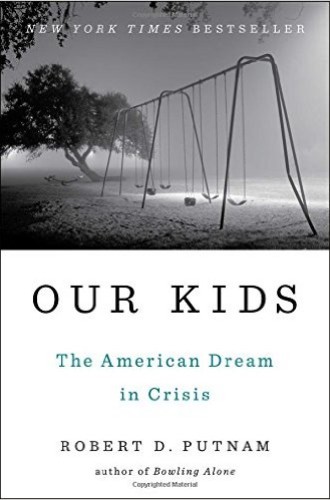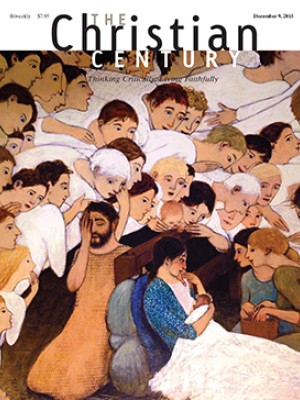Our Kids, by Robert D. Putnam
The claim is a familiar one, taught by parents, reinforced by teachers, and pledged by politicians: work hard and you will get ahead. Study, apply yourself, and prosper. As a nation with no identifying religion, culture, or cuisine, the United States has, in many ways, been defined by this simple but powerful promise: a better life comes to those who take advantage of talent and opportunity through hard work. This promise is the basis of the American dream. Increasingly it may be a lie.
Robert D. Putnam, professor of public policy at Harvard, paints a sobering picture of the current state of the American dream. Balancing biographical examples and the latest quantitative sociological research, Putnam describes an America where success is increasingly determined by where one is born and to whom, rather than how hard one works.
Read our latest issue or browse back issues.
The nation is facing a troubling, even disorienting shift that may well be unique in our history. On average, young Americans today are less educated, less prosperous, less likely to own a home, less politically potent, and less socially and economically mobile than their counterparts of a generation before. In the United States of the 21st century, birthright has come to mean significantly more than effort in determining who succeeds and who does not.
According to Putnam, this reality is in stark contrast to the picture 50 years ago:
The most rigorous economic and social history now available suggests that socioeconomic barriers in America . . . in the 1950s were at their lowest ebb in more than a century: economic and educational expansion were high; income equality was relatively high; class segregation in neighborhoods and schools was low; class barriers to intermarriage and social intercourse were low; civic engagement and social solidarity were high; and opportunities for kids born in the lower echelon to scale the socioeconomic ladder were abundant.
Presenting his hometown of Port Clinton, Ohio, as a microcosm of the shift, Putnam looks at his high school class of 1959. In contrast to their working-class and middle-class parents—only one in 20 of whom had graduated from college—Putnam’s classmates experienced “astonishing upward mobility” over their lifetimes. One-third of his classmates were the first in their families to graduate from high school. Three-quarters attained a higher education level than their parents. A number of the less well-off students ended up advancing in both education and wealth beyond their peers from wealthier families. Poverty existed in Port Clinton in 1959, but it was evenly distributed across census tracts and never topped 15 percent of the population in any one area.
Today, Port Clinton is a very different place. The town is bifurcated economically. The lakefront census tracts on the north part of town have a poverty rate of 1 percent; those to the south have a poverty rate of 51 percent. The average child born in Port Clinton today will attain a lower education level, have less social mobility, have less access to health care, and be less prosperous than the average child born in the 1950s. As Putnam explains, “The opportunity gap has widened dramatically, partly because affluent kids now enjoy more advantages than affluent kids [of the 1950s], but mostly because poor kids now are in much worse shape than their counterparts then.”
If Port Clinton were an outlier—an isolated instance of Rust Belt decline—the story would end here. But Putnam finds the same troubling trends in parts of the country that are booming by comparison: Bend, Oregon; Orange County, California; Atlanta, Georgia. By almost every measure, the gap between rich and poor has been widening across the United States since the 1970s. Between 1979 and 2005, average income levels for the poorest fifth of Americans increased by $900 a year. Over the same quarter century, average income levels for the wealthiest 1 percent of Americans grew by an astounding $745,000 a year. (These figures are adjusted for inflation.)
The value of a college degree has also increased. Between 1989 and 2013, the net worth of college-educated households rose by 47 percent, while the net worth of households in which the highest educational attainment was high school fell by 17 percent. At the same time, access to a college degree has increasingly become a product of income and class. The likelihood that an upper-income American will earn a college degree has more than doubled since 1970, to over 80 percent, while the likelihood that an American from the lowest economic quartile will graduate from college has increased by only 2 percentage points, from 6 percent to 8 percent. It is now ten times more likely that a child born into a wealthy American family will earn a college degree than a child from a low-income family.
These widening economic and educational divides are having a profound impact on family life. The chance that a family will dine together in the evening has decreased across the board since the 1970s, but the drop has been twice as large for families in which parents have a high school or lower level of education compared to families with college-educated parents. Over this same period, the amount of time college-educated parents spend with their preschool children on developmental experiences (activities such as reading and playing educational games) has climbed to 130 minutes a day. Among parents with a high school degree or less, the figure is about 80 minutes a day. The explanation for these changing family patterns is simple: faced with growing economic challenges, many less-educated parents must work more, often at multiple jobs, at the expense of spending time with their children.
Economic pressures are affecting religious practice as well. According to Putnam, “religious engagement has traditionally been less class-biased than virtually any other sort of community or extracurricular activity.” This has been important, he reports, because church-going children on average have better relations with their parents and more friendships and are less likely to abuse drugs and alcohol. Today, however, “poor families are generally less involved in religious communities than affluent families.” The average college-educated family now attends church about 28 weeks per year. The number goes down to 20 weeks for the average high school–educated family.
To this already disturbing picture, Putnam adds that less-educated Americans are more likely to be teenage parents, to be single parents, to be unemployed, to be obese, to lack adequate health care, to be politically disengaged, and to be imprisoned. In each of these areas, the gap between wealthy and poor Americans has widened over the past generation. What has emerged, according to Putnam, are “two Americas”—one in which prosperity is all but guaranteed by birth; the other in which even hard work and talent are not enough to overcome the odds.
Putnam’s recommended solutions to the predicament—“rehabilitate ex-prisoners,” “move poor families to better neighborhoods”—are disappointingly perfunctory, but this may be beside the point. By weaving together an impressive array of personal stories and empirical evidence, Our Kids convincingly documents the unraveling of the American dream and forces us to ask a fundamental question: If the United States is not the land of equal opportunity, then what is it?






